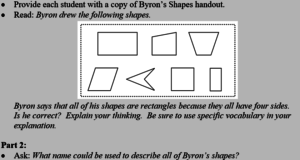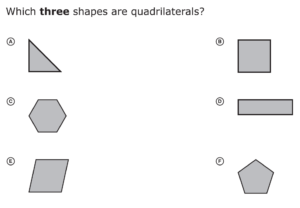Understand that shapes in different categories (e.g., rhombuses, rectangles, and others) may share attributes (e.g., having four sides), and that the shared attributes can define a larger category (e.g., quadrilaterals). Recognize rhombuses, rectangles, and squares as examples of quadrilaterals, and draw examples of quadrilaterals that do not belong to any of these subcategories.
[divider] [/divider] Students are able to…
- Describe and compare the attributes of two-dimensional shapes.
- Draw examples and non-examples of quadrilaterals.
- Use precise vocabulary to describe the attributes of a quadrilateral. For example, 4 sides and angles.
[divider] [/divider] Students are able to…because teachers:
- Provide multiple opportunities and manipulatives for students to explore quadrilaterals.
- Model precise vocabulary.
- Provide opportunities for the students to use precise vocabulary and make sense of their learning.
- Pose tasks where students can sort and compare shapes.
[divider] [/divider] Questions to ask students:
- What is the name of that shape (point to shape on paper or that student is currently working with)? How do you know? Are there any other names for that shape?
- Sample answer that indicates understanding: The shape is a quadrilateral, because it has 4 sides and 4 vertices. It is also a rectangle, because it has 4 square angles and the opposite sides are the same length.
- How are a square and a rectangle related?
- Sample answer that indicates understanding: A square is a rectangle. A square has 4 congruent sides and 4 right angles. A rectangle has 4 sides and 4 angles, but the sides do not have to be congruent.
- Sample answer that indicates an incomplete understanding or a misconception: They are the same because they both have 4 sides and 4 angles.
- Draw a shape that is not a quadrilateral.
- Sample answer that indicates understanding: Draws a shape that has a number of sides other than 4.
[divider] [/divider] FSA Notes
Cognitive Complexity Level: 2 – Basic Application of Skills and Concepts
Achievement Level Descriptors:
2- identifies rhombuses, rectangles, and squares as examples of quadrilaterals; explains that quadrilaterals have shared attributes, and that the shared attributes can define a larger category
3- sorts examples of quadrilaterals that have shared attributes and that the shared attributes can define a larger category; draws examples of quadrilaterals that do not belong to the categories of rhombuses, rectangles, and squares
4- draws examples and nonexamples of quadrilaterals that are not rhombuses, rectangles, or squares
5- explains the common attributes between quadrilaterals
Assessment Limits:
Shapes may include two‐dimensional shapes and the following quadrilaterals: rhombus, rectangle, square, parallelogram, and trapezoid.
Items may reference and/or rely on the following attributes: number of sides, number of angles, whether the shape has a right angle, whether the sides are the same length, and whether the sides are straight lines.
Items may not use the terms “parallel” or “perpendicular.”
Items that include trapezoids must consider both the inclusive and exclusive definitions.
Items may not use the term “kite” but may include the figure.
[divider] [/divider] Additional Resources:
Additional in depth content knowledge
Blog Posts:
Naming and Describing Quadrilaterals in 3rd Grade

